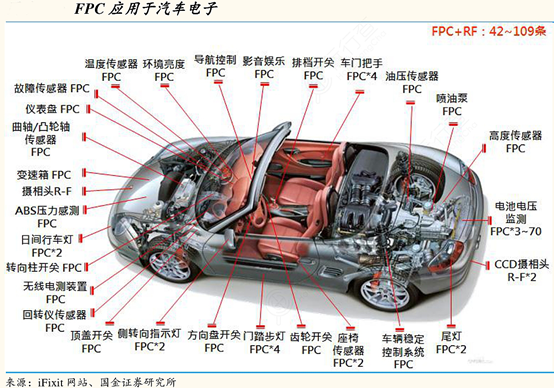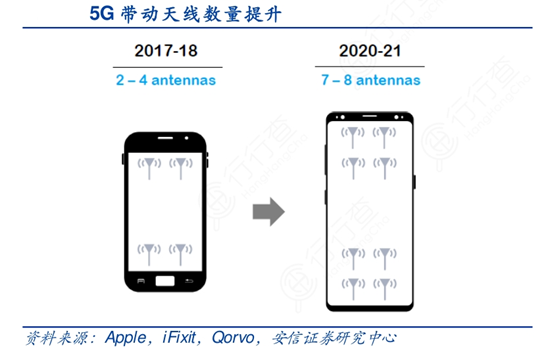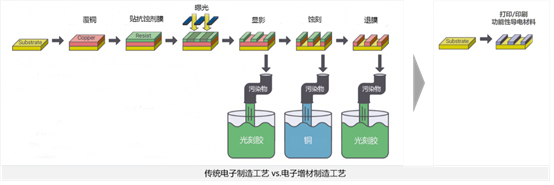Flexible means soft and not hard, which is the opposite of "rigid". Flexible electronics is an emerging electronic technology that installs electronic circuits on a flexible substrate. Compared with traditional electronic technology, flexible electronics has greater flexibility, unique softness and ductility. With the global popularization of information technologies such as the Internet, big data, cloud computing, and artificial intelligence, the flexible electronics industry has shown a good development momentum and has a wide range of application needs in the fields of medical care, information, energy, and national defense.
Flexible electronics are leading the leapfrog development of multiple industries
With the commercialization of foldable screen mobile phones, VR tactile gloves, and flexible screens in the consumer electronics market, flexible electronic technology is gradually becoming known to more and more people. This black technology that gives traditional rigid products a flexible form is quietly changing our lives. According to international authoritative organizations, the overall flexible electronics industry is expected to reach a scale of US$301 billion by 2028, in a long-term high-speed growth trend. As a basic component of flexible electronics, flexible circuit boards (FPCs) are being used in more and more fields.
FPC is highly compatible with new energy vehicles, and the demand for new energy and automotive electronics is being released rapidly . FPC has the characteristics of lightweight, simple structure, and easy line connection. It is a good line carrier for connecting automotive electronic components. It has obvious advantages in safety, assembly efficiency, endurance, and reduced weight. The FPC connection solution has become the absolute main solution in passenger car power batteries. According to a survey in 2018, CATL and BYD, the first echelon of domestic power batteries, have already applied FPC in batches in the packing link. Public information shows that Tesla, Guoxuan High-tech, AVIC Lithium Battery, Tafel, Xinwanda, Farasis and other companies have also begun to apply FPC. At present, the FPC solution has become the main choice for most new models of new energy vehicles.

At the same time, the advantages of FPC in bendability, weight reduction, and high degree of automation are further reflected, and its applications cover related scenarios such as headlights, display modules, three major power control systems of BMS/VCU/MCU, sensors, and advanced assistance systems. From the perspective of the main downstream application structure, the demand for FPC in consumer electronics has steadily increased. According to Prismark data, in 2019, the global FPC output value was mainly concentrated in the fields of communications electronics and computers, of which communications electronics accounted for 33.0% and computers accounted for 28.6%. Consumer electronics, mainly mobile phones, constituted the main contribution to the scale of FPC output value. With the emergence of applications such as folding screens, virtual buttons, and multi-camera modules, coupled with the demand for lightweight design, the application space of FPC in smartphones has further expanded. The main application scenarios include flexible screens, cameras, vibrators, screen touch, antennas, receivers, microphones, FPC connectors, etc.
其中FPC连接器需求提升显著。作为柔性电路板的一个功能部件,FPC连接器在以智能手机为代表的电子设备迅速向小型化方向发展的背景下,已是目前消费类电子设备内部采用柔性电路来连接电路板的主要连接方式。


The high-frequency requirements in the 5G era drive the penetration rate of FPC antennas to increase. The development demand for product miniaturization and intelligence has prompted most antennas in terminal communication equipment to adopt a thinner and softer FPC structure. For example, Apple has used FPC antenna design since the first generation of iPhone. With the advent of the 5G era, major countries around the world plan to use medium-frequency 3-5GH2 and high-frequency and millimeter-wave bands above 20GHz, and the wavelength and antenna size will be reduced accordingly. At the same time, due to the maturity of multi-input multi-output (MiMO) and array antenna technology, the scale of the built-in main communication antenna unit will change from 2*2 and 4*4 in the 4G era to 8*8 or even 16*16, that is, the number of main channel antennas will change from 2 or 4 to 8 or even 16, which will greatly increase the number of single-machine antennas, and the use of high-frequency FPC will also rise accordingly.

New products represented by flexible sensors are leading the innovation and transformation in the fields of health care, information technology, etc. In the future, artificial intelligence, including the concept of metaverse and Internet of Things, will be highly dependent on the technical implementation and industrial opening of flexible electronics in intelligent sensing. The characteristics of FPC, such as lightness, softness, and bendability, fully meet the characteristics of medical equipment that need to be integrated with the human body. The development of flexible electronics has greatly inspired health science. A large number of wearable/implantable devices have been developed around the human body, which has greatly enriched the means of health data collection and disease detection.
In information technology, the metaverse has become a hot concept, and flexible sensing may make the concept of the metaverse a reality. People can use transparent, flexible, extensible, freely bendable and foldable electronic skin made of flexible electronics to accurately feel touch and taste in real time, truly entering the era of the metaverse.
The application of additive manufacturing technology of "materials + processes" may bring greater breakthroughs to flexible electronics
Applications at all levels in the field of flexible electronics are experiencing a full-scale explosion, with increasingly higher requirements for high customization, fast delivery, high quality, and low cost, which has put forward higher and more urgent demands on product design, process level, manufacturing capabilities, and even the research and development of underlying materials. With the emergence of a large number of new applications and the environmental protection requirements for production and manufacturing in the context of the times, traditional electronic manufacturing technology can no longer fully meet the requirements. Applying cutting-edge additive manufacturing technology to electronic manufacturing has become a development trend, and more and more manufacturers have begun to conduct research, exploration, and application attempts on electronic additive manufacturing technology.
Electronic additive manufacturing technology uses optimized graphic printing as an additive manufacturing process to form functional conductive materials on a substrate at one time without the need for subsequent subtractive processes. Compared with traditional electronic manufacturing methods, electronic circuits are manufactured in a "subtractive" mode, which is complex and costly, not only time-consuming and energy-consuming, but also highly polluting to the environment. Additive manufacturing, on the other hand, uses direct printing or printing, which has a simple process and can effectively improve production efficiency and reduce production costs. It has natural advantages such as lightweight, flexibility, and green environmental protection. In addition, electronic additive manufacturing technology can realize the direct printing/printing of electronic circuits on flexible, ultra-thin and even stretchable substrates and three-dimensional object surfaces. It is less restricted by the substrate and can more easily meet the needs of new flexible electronic applications.

Driven by demands for new application scenarios, cost, efficiency, and environmental protection, many companies in the materials field or traditional printing field have begun to explore the use of conductive materials for circuit printing. However, this technology has not been quickly applied and widely promoted.
The two cores of electronic additive manufacturing technology are: materials + processes, and the two complement each other and cannot be isolated. Companies that focus on material research lack process development capabilities, and most companies that focus on engineering implementation do not have a material research background. Few companies can achieve both the bottom-level material research and development and the subsequent manufacturing process. This requires companies to have the genes for material research and development as well as sufficient patience and investment.
Integrating materials and processes has become a pressing issue to be addressed in the development of electronic additive manufacturing technology, and will also bring new development opportunities for the flexible electronics industry.
Mengzhimo provides a full-stack flexible electronic additive manufacturing solution of "materials + processes"
As a technology transformation company focusing on conductive metal materials, Mengzhimo has been deeply engaged in the field of electronic additive manufacturing for a long time and has achieved the successful application of various types of additive manufacturing methods in electronic manufacturing, such as silk screen printing, transfer printing, direct writing, etc.
Fine pattern printing: It can realize direct printing of fine conductive lines on the surface of multi-material, ultra-thin, low temperature resistant substrates, such as PI/MPI/LCP/ITO soft film/TPU/TPE, etc., and supports direct printing on film materials with a thickness of less than 10μm.
Three-dimensional circuit forming: It can quickly realize the direct printing of circuits on the outer surface of objects, the decomposition printing of circuits on the surface of complex inner cavity structures, and the printing of circuits on the surface of structures with small curvature.
Previous article:Up to 8% of corporate inventory is wasted, further exacerbating the supply chain crisis
Next article:Siemens and EPLAN enter into strategic partnership
- Molex leverages SAP solutions to drive smart supply chain collaboration
- Pickering Launches New Future-Proof PXIe Single-Slot Controller for High-Performance Test and Measurement Applications
- CGD and Qorvo to jointly revolutionize motor control solutions
- Advanced gameplay, Harting takes your PCB board connection to a new level!
- Nidec Intelligent Motion is the first to launch an electric clutch ECU for two-wheeled vehicles
- Bosch and Tsinghua University renew cooperation agreement on artificial intelligence research to jointly promote the development of artificial intelligence in the industrial field
- GigaDevice unveils new MCU products, deeply unlocking industrial application scenarios with diversified products and solutions
- Advantech: Investing in Edge AI Innovation to Drive an Intelligent Future
- CGD and QORVO will revolutionize motor control solutions
- Innolux's intelligent steer-by-wire solution makes cars smarter and safer
- 8051 MCU - Parity Check
- How to efficiently balance the sensitivity of tactile sensing interfaces
- What should I do if the servo motor shakes? What causes the servo motor to shake quickly?
- 【Brushless Motor】Analysis of three-phase BLDC motor and sharing of two popular development boards
- Midea Industrial Technology's subsidiaries Clou Electronics and Hekang New Energy jointly appeared at the Munich Battery Energy Storage Exhibition and Solar Energy Exhibition
- Guoxin Sichen | Application of ferroelectric memory PB85RS2MC in power battery management, with a capacity of 2M
- Analysis of common faults of frequency converter
- In a head-on competition with Qualcomm, what kind of cockpit products has Intel come up with?
- Dalian Rongke's all-vanadium liquid flow battery energy storage equipment industrialization project has entered the sprint stage before production
- Allegro MicroSystems Introduces Advanced Magnetic and Inductive Position Sensing Solutions at Electronica 2024
- Car key in the left hand, liveness detection radar in the right hand, UWB is imperative for cars!
- After a decade of rapid development, domestic CIS has entered the market
- Aegis Dagger Battery + Thor EM-i Super Hybrid, Geely New Energy has thrown out two "king bombs"
- A brief discussion on functional safety - fault, error, and failure
- In the smart car 2.0 cycle, these core industry chains are facing major opportunities!
- The United States and Japan are developing new batteries. CATL faces challenges? How should China's new energy battery industry respond?
- Murata launches high-precision 6-axis inertial sensor for automobiles
- Ford patents pre-charge alarm to help save costs and respond to emergencies
- New real-time microcontroller system from Texas Instruments enables smarter processing in automotive and industrial applications
- [Repost] Why are lithium iron batteries less likely to leak than alkaline batteries?
- Bear Pie Huawei IoT Operating System LiteOS Kernel Tutorial 02-HelloWorld
- MSP432 development board serial port debugging
- Let's study together. This e-book is well written in Chinese.
- Where do you go to buy components? e-Network has spot products and can receive them the next day.
- RFID related CPU card
- EEWORLD University Hall----TI Cup 2019 National College Student Electronic Design Competition Topic Analysis and Technical Exchange Seminar
- [Raspberry Pi Pico Review] - Unboxing + Download
- Hydrogen escape problem
- How do I convert a^(b^2) to the power of a^b?



 Siemens Motion Control Technology and Engineering Applications (Tongxue, edited by Wu Xiaojun)
Siemens Motion Control Technology and Engineering Applications (Tongxue, edited by Wu Xiaojun) CVPR 2023 Paper Summary: Document Analysis and Understanding
CVPR 2023 Paper Summary: Document Analysis and Understanding
















 京公网安备 11010802033920号
京公网安备 11010802033920号